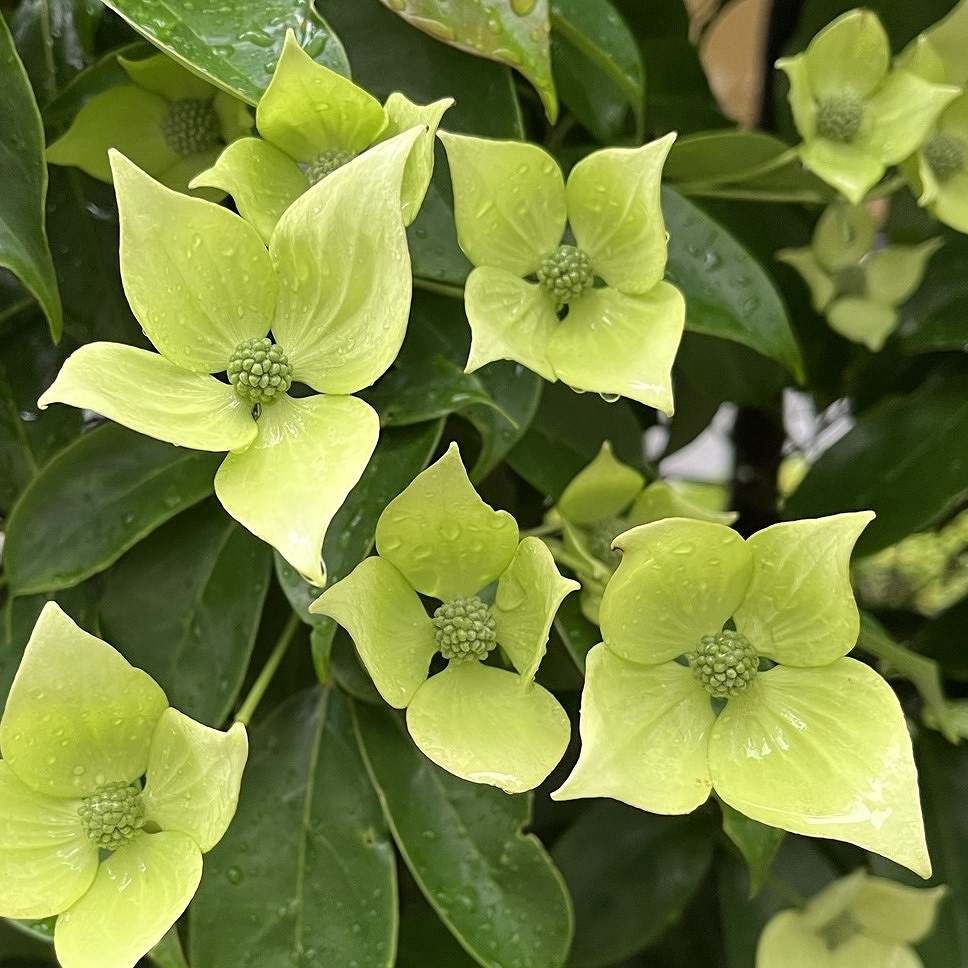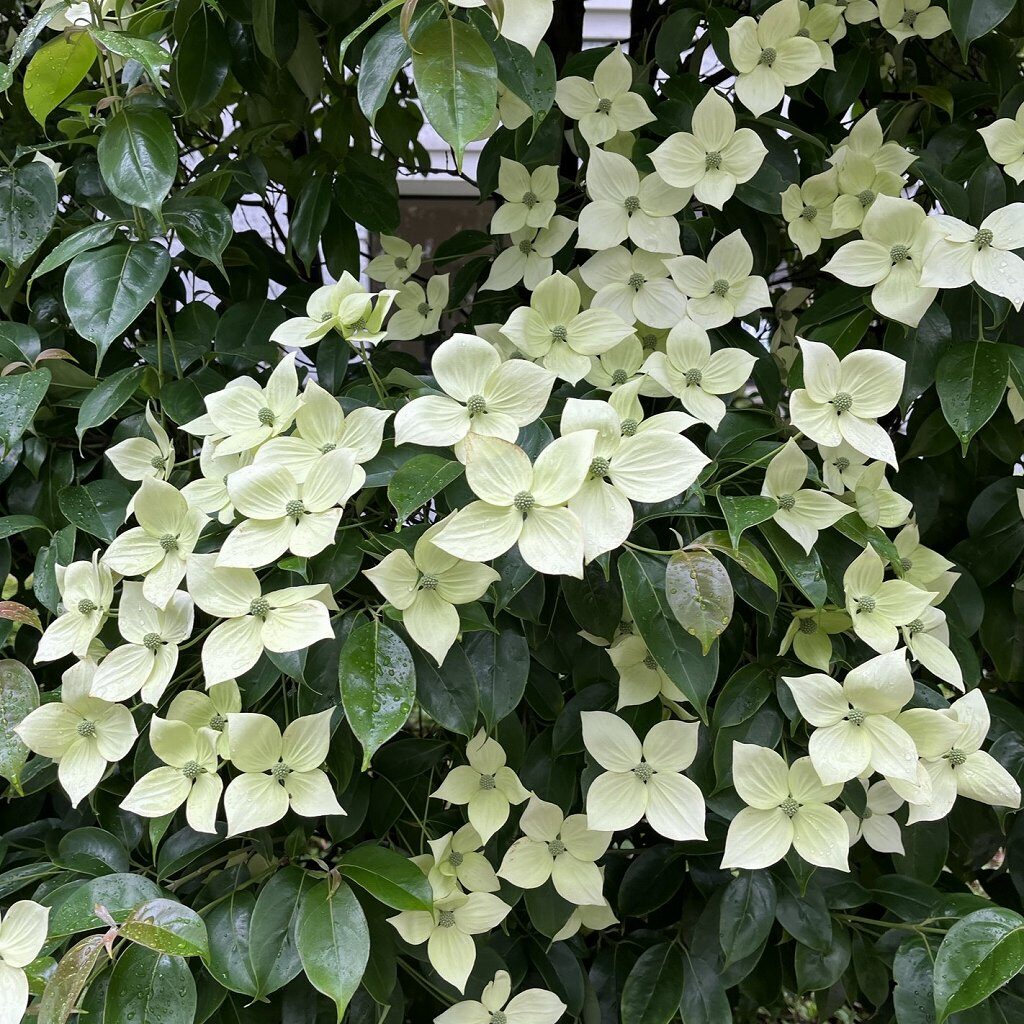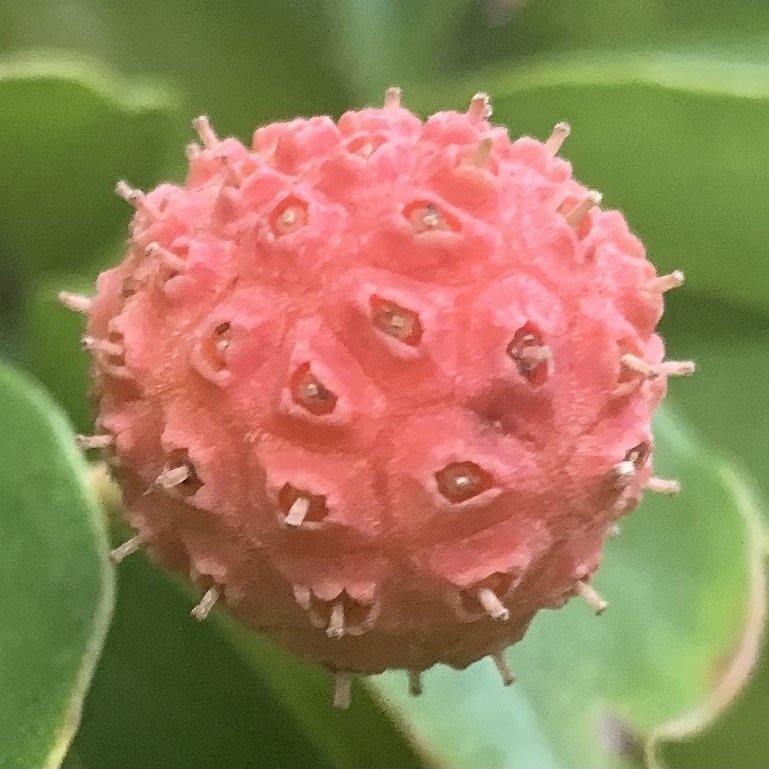ヤマボウシの名前の由来は、かつて「山法師」と呼ばれた比叡山延歴寺の僧兵。丸い集合花が坊主頭に、白い総苞片が頭巾に見えるからです。
The origin of the name of Kousa dogwood is the monk soldier of Hieizan Enryakuji Temple, which was once called “Yamaboshi: Mountain monk”. This is because the round collective flowers look like a monk head, and the white total bracts look like a headband.
【仮名】ヤマボウシ
【和名】山法師
【英名】Kousa Dogwood
【学名】Cornus kousa
【誕生】05/ 21, 06/ 15
【開花】05, 06, 07月
【花色】White, Pink, Red, Yellow






ヤマボウシ
ヤマボウシの分布
ヤマボウシはミズキ科の落葉高木です。日本では本州の東北地方南部から四国、九州、沖縄まで、国外では朝鮮半島、中国に分布。山地の林内や林縁など、湿ったところに自生し、公園や庭園、街路に植栽されます。寒さに強く、植栽北限は北海道札幌市周辺。花言葉は「友情」です。
ヤマボウシの名前
ヤマボウシの名前の由来は、かつて「山法師」と呼ばれた比叡山延歴寺の僧兵。真ん中の丸い集合花が坊主頭に、4枚の白い総苞片が頭巾に見えるからです。ラテン語の属名コルナスは「角」という意味。材が堅いからです。種名コウサは昔、この木が箱根で「くさ」と呼ばれたから。
ヤマボウシの花
ヤマボウシの花は枝先に着きます。花数が多いので、満開時は重みで枝が垂れるほど。花弁のように見えるのは花弁でなく、葉に由来する白い総苞片です。真ん中の淡黄緑色の球体は、花弁4枚に雌しべ1本と雄しべ4本の小さな花の集まり。花一つ一つが受粉して集合果になります。
ヤマボウシの実
ヤマボウシは花が終わると、丸い集合花がそのまま丸い集合果に。秋に赤く熟し、中に乳白色の種子が8粒入ります。果肉は柔らかく甘味があり、生食のほか果実酒などに加工可能。桑の実に似ていることから、山法師には「山桑」という別名や「童泣かせ」などの地方名があります。
ヤマボウシの近縁
ヤマボウシの近縁種には、冬でも落葉しない「常盤山法師」、花が淡い紅色の「紅山法師」などがあります。改良品種は、花付きがよく、葉が丈夫な「ミルキーウェイ」、花が赤色の「源平」、黄色の「金陽」、葉に斑が入る「ウルフアイ」、実が大きくなる「ビッグアップル」など。
ヤマボウシの遠縁
ヤマボウシに似ている「花水木」は遠縁です。山法師は葉が出てから花が咲き、総苞片の先端が尖り、樹皮が明るくツルツル。実が柔らかく甘く、食べられます。一方、花水木は葉が出る前に花が咲き、総苞片の先端が凹み、樹皮が暗くゴツゴツ。実が固く有毒なので食べられません。
Kousa Dogwood
Distribution of Kousa dogwood
Kousa dogwood is a deciduous tree of the Cornaceae family. In Japan, it is distributed from the southern part of the northeastern region of Honshu to Shikoku, Kyushu, and Okinawa, and overseas, it is distributed in the Korean Peninsula and China. It grows naturally in moist places such as in mountain forests and forest edges, and is planted in parks, gardens, and streets. Strong against the cold, the northern limit of planting is around Sapporo City, Hokkaido. The flower language is “friendship.”
Kousa dogwood name
The origin of the name of Kousa dogwood is the monk soldier of Hieizan Enryakuji Temple, which was once called “Yamaboshi: Mountain monk”. This is because the round flower in the middle looks like a monk head, and the four white pieces of bracts look like a headband. The Latin genus name Cornus means “horn”. Because the material is hard. The species name Kousa used to be called “Kusa” in Hakone.
Kousa dogwood flower
The flowers of Kousa dogwood bloom at the tip of the branch. Since there are many flowers, the weight of the flowers makes them hang down when they are in full bloom. What looks like petals is not the petals, but the white total bracts derived from the leaves. The pale yellow-green sphere in the middle is a collection of small flowers with four petals, one female stamen and four male stamens. Each flower is polluted and becomes a collective fruit.
Kousa dogwood fruit
When the flowers of Kousa dogwood are finished, the round collective flowers become round collective fruits. It ripens red in autumn and contains 8 milky white seeds. The flesh is soft and sweet, and can be eaten as it is and processed into fruit liquor. Because it resembles a mulberry fruit, Kousa dogwood has an alias called “Yamaguwa: mountain mulberry” and a local name such as “Warabe Nakase: Children’s crying”.
Close relatives of Kousa dogwood
Related species of Kousa dogwood include “hongkongensis”, whose leaves do not fall even in winter, and “rosea”, whose flowers are pale red. Improved varieties include “Milky Way,” which has good flowers and strong leaves, “Genpei,” which has red flowers, “Kinyou,” which has yellow flowers, “Wolf Eye,” which has spots on the leaves, and “Big Apple,” which grows larger. ..
Distant relative of Kousa dogwood
“Cornus florida”, which resembles Kousa dogwood, is a distant relative. Kousa dogwood has flowers after the leaves come out, the tips of the total bracts are sharp, and the bark is bright and smooth. The fruits are soft and sweet and can be eaten. On the other hand, Cornus florida has flowers before the leaves come out, the tips of the total bracts are dented, and the bark is dark and rugged. The fruit is hard and toxic, so can not be eaten.


